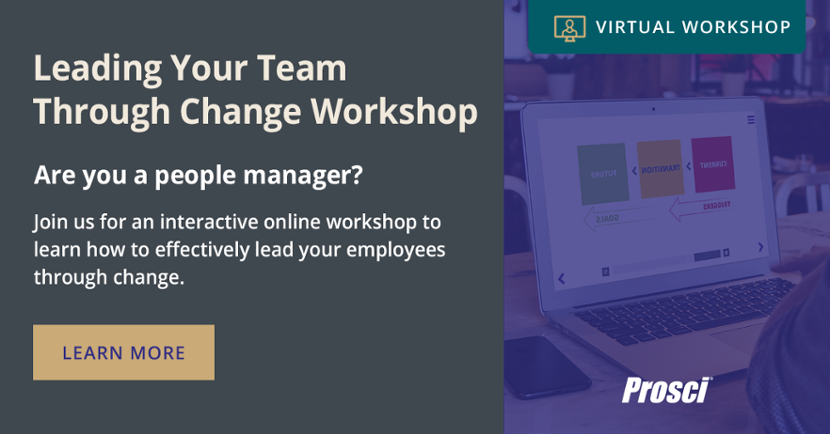5 Key Roles of People Managers in Leading Change

3 Mins
Updated: November 1, 2024
Published: March 29, 2023

During my change management career, I have trained, coached and collaborated with hundreds of people managers on how to lead change effectively. And I have developed a deep appreciation for how important people managers are to successfully implementing change in organizations. But as a people manager, you may not fully understand just how important your role is in enabling a successful change. What should you be doing to effectively lead change with your team?
Understanding CLARC
A people manager has day-to-day operational responsibilities, but when it comes to change, you have additional and critical work to do. To support your team members and help them successfully adopt and use changes, Prosci’s Best Practices in Change Management research identifies five key roles of people managers:
- Communicator
- Liaison
- Advocate
- Resistance Manager
- Coach
To remember these five roles, simply remember CLARC and picture yourself as the Clark Kent (Superman’s alter ego) of change leaders. When you perform these five roles, you will have a positive influence on building Awareness, Desire, Knowledge, Ability and Reinforcement (ADKAR) for each member of your team. Remember, the ADKAR Model is what enables individuals to adopt and use the change.

 The CLARC + ADKAR Connection
The CLARC + ADKAR Connection
Let’s look at what’s involved in performing each of the five roles, how the roles influence the elements of ADKAR, and the risks involved if you don’t perform the roles. These relationships comprise what we call the CLARC + ADKAR Connection.
Communicator
The communicator role is arguably the most important of the five roles because it stands on its own and is required to fulfill the other four roles. According to Prosci research, a lack of Awareness about why a change is needed is the primary reason employees resist change. Your role as a Communicator is to build Awareness of the need for change by answering the most important questions your team members have about the personal impacts of a change. Such questions include “Why?” “Why now?” “What if?” and “How does it impact me or us?” If you don’t communicate effectively, the risk is that your team will lack Awareness about why changes are being made, which leads to increased resistance.
Liaison
As a people manager, you are an important source of feedback to the project team and change sponsors regarding implementation progress with your team and whether the change is delivering expected benefits. If the project team isn’t asking your for input, speak out. Without your feedback during the design and implementation phases of a change, you risk allowing the project team to “fly blind.” They will not know if the change is providing the proper functionality or how effectively it’s being adopted. By performing the liaison role, you can have a positive impact on Reinforcement, ensuring that your team members will continue to apply the change over time.
Advocate
People managers are influential. If you advocate strongly for a change through your words and actions, you will influence your team members' Desire. They will follow your lead and be willing to participate in and support the change. If you don’t believe in the change yourself or don’t advocate for it, you risk sending the unintended message that the change is not important, which will create barrier points at Desire for your team.
Resistance manager
Resistance is a natural human reaction to change. Expect resistance. Don’t let it surprise you. To effectively lead change, you need to be a thoughtful resistance manager, which means determining the root cause of resistance and applying tactics that address that root cause. If you address resistance and celebrate progress in adopting and using the change, you will have a positive impact on the Desire and Reinforcement elements of the ADKAR Model.
Coach
As coach, people managers must support team members to gain the Knowledge they need about how to change and develop the Ability to adopt and use the change in their daily work. If you are an effective coach, you will have a positive impact on the Knowledge and Ability elements of the ADKAR Model for your team members.
People Managers and Change
As a change practitioner, I often develop specific plans for implementing a change, but it’s the people managers of the impacted groups who do much of the work in executing the plans. When you understand and execute the five key roles of CLARC, you can make a significant impact on employees, help them move past barriers to adoption, and enjoy successful outcomes from change. Given the urgency and volume of changes we’re experiencing today, your contributions to change have never been more important.
Prosci AI-powered assistant, Kaiya, supports people managers by providing tailored insights, strategies and tools to enhance effectiveness in each of the CLARC roles. Kaiya helps you can navigate change more efficiently and ensure that your team successfully adopts and sustains changes.


